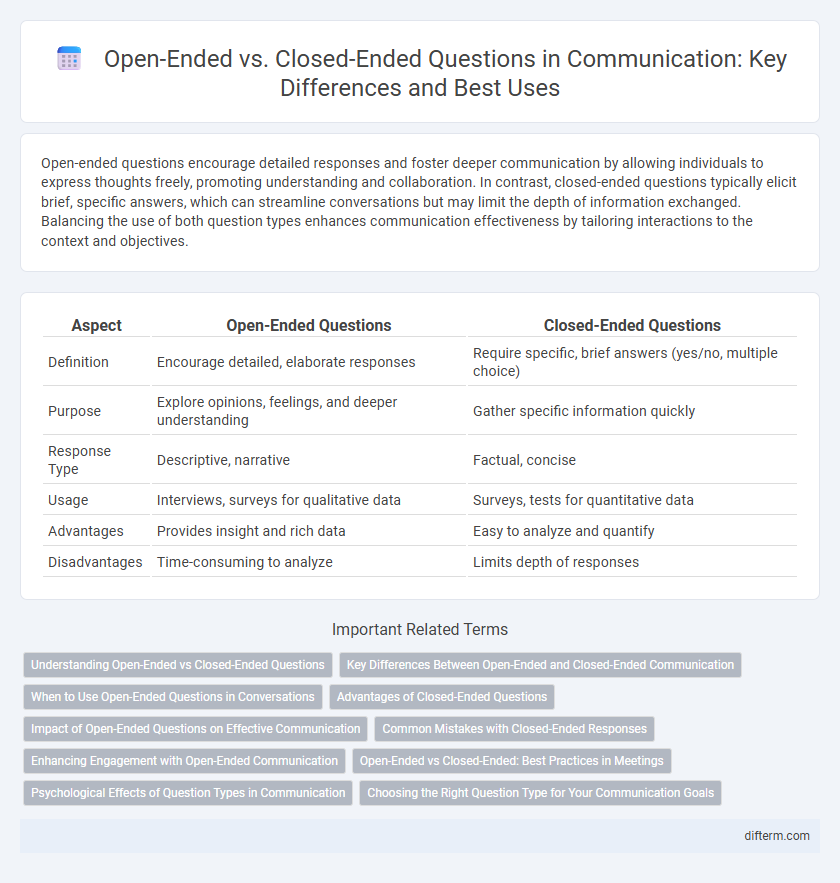Open-ended questions encourage detailed responses and foster deeper communication by allowing individuals to express thoughts freely, promoting understanding and collaboration. In contrast, closed-ended questions typically elicit brief, specific answers, which can streamline conversations but may limit the depth of information exchanged. Balancing the use of both question types enhances communication effectiveness by tailoring interactions to the context and objectives.
Table of Comparison
| Aspect | Open-Ended Questions | Closed-Ended Questions |
|---|---|---|
| Definition | Encourage detailed, elaborate responses | Require specific, brief answers (yes/no, multiple choice) |
| Purpose | Explore opinions, feelings, and deeper understanding | Gather specific information quickly |
| Response Type | Descriptive, narrative | Factual, concise |
| Usage | Interviews, surveys for qualitative data | Surveys, tests for quantitative data |
| Advantages | Provides insight and rich data | Easy to analyze and quantify |
| Disadvantages | Time-consuming to analyze | Limits depth of responses |
Understanding Open-Ended vs Closed-Ended Questions
Open-ended questions encourage detailed responses, fostering deeper understanding and engagement by allowing individuals to express thoughts freely. Closed-ended questions limit answers to predefined options, enabling quick data collection and precise analysis. Understanding the strategic use of open-ended versus closed-ended questions enhances communication effectiveness in interviews, surveys, and everyday interactions.
Key Differences Between Open-Ended and Closed-Ended Communication
Open-ended communication encourages detailed responses by inviting elaboration and personal insight, fostering deeper understanding and engagement. Closed-ended communication limits responses to specific options, often yes or no answers, which streamlines information gathering but can restrict nuance. Key differences include the scope of information elicited and the potential for dialogue depth, with open-ended questions promoting exploration and closed-ended ones ensuring clarity and brevity.
When to Use Open-Ended Questions in Conversations
Open-ended questions are ideal when fostering deep communication, encouraging detailed responses and promoting understanding in conversations. Use open-ended questions to explore feelings, gain insights, and stimulate critical thinking, especially in counseling, interviews, or collaborative discussions. These questions help build rapport and uncover valuable information that closed-ended questions might miss.
Advantages of Closed-Ended Questions
Closed-ended questions provide clear, concise answers that simplify data collection and analysis, making them ideal for quantitative research and structured interviews. They help maintain control over the conversation flow, ensuring specific information is obtained efficiently. Their design reduces ambiguity, which enhances the accuracy and comparability of responses in communication contexts.
Impact of Open-Ended Questions on Effective Communication
Open-ended questions foster deeper engagement by encouraging detailed responses and revealing underlying thoughts, which enhances mutual understanding and trust. These questions promote active listening, enabling communicators to clarify intentions and address concerns more effectively, leading to stronger relationships. As a result, open-ended inquiries drive richer dialogues, improving problem-solving and collaboration in personal and professional settings.
Common Mistakes with Closed-Ended Responses
Closed-ended responses often lead to common communication mistakes such as limiting the depth of conversations and reducing emotional expression. These responses can create barriers to understanding by eliciting simple yes/no or one-word answers that hinder detailed feedback. Overuse of closed-ended questions can result in missed opportunities for clarification and decreased engagement in dialogues.
Enhancing Engagement with Open-Ended Communication
Open-ended communication fosters deeper engagement by encouraging respondents to share detailed thoughts, feelings, and perspectives, leading to richer and more meaningful interactions. Unlike closed-ended questions that limit answers to predefined options, open-ended questions stimulate critical thinking and creativity, enhancing rapport and trust. This dynamic approach promotes active listening and dialogue, essential for building strong interpersonal connections and effective communication.
Open-Ended vs Closed-Ended: Best Practices in Meetings
Open-ended questions foster elaborate discussions by encouraging participants to share insights and perspectives, promoting creativity and problem-solving in meetings. Closed-ended questions yield specific, concise answers that help clarify decisions or gather quick consensus, ensuring meetings stay efficient and focused. Balancing both types according to the meeting's goal enhances engagement while maintaining structure and productivity.
Psychological Effects of Question Types in Communication
Open-ended questions promote psychological safety, encouraging individuals to express thoughts freely, which enhances trust and rapport in communication. Closed-ended questions often limit responses, potentially triggering defensiveness or disengagement due to perceived constraints on expression. Tailoring question types to context can optimize interpersonal dynamics and foster deeper understanding.
Choosing the Right Question Type for Your Communication Goals
Selecting the appropriate question type significantly impacts the effectiveness of communication by aligning with specific goals; open-ended questions encourage detailed responses and deeper engagement, while closed-ended questions yield concise, straightforward answers ideal for quick information gathering. Understanding the context and desired outcome helps determine whether to foster exploration and elaboration through open-ended queries or to prioritize clarity and efficiency with closed-ended ones. Tailoring question types enhances dialogue quality, driving clearer understanding and more productive interactions.
open-ended vs closed-ended Infographic

 difterm.com
difterm.com